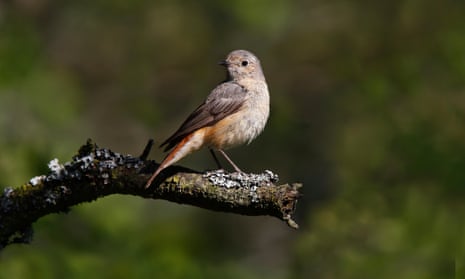The wind crashes through the tree tops, like the sea breaking on the shore, the great pines and silver birches that encircle the heathland swaying and shimmering. A red admiral butterfly rises from the heather, but it is snatched up by the wind and tumbles away too quickly for me to follow it.
I walk along the muddy track that threads between the trees. Where only last week the ground had been dry and parched, offering very little moisture to thirsty animals and birds, now all the pools are replenished with just one day’s heavy rain. I stop to watch three goldfinches drink from a puddle in front of me.
There is movement in the scrub on one side of the path. Small birds – goldcrests and blue tits – hop from branch to branch. There are other, larger birds moving through the cover of the young birches. I can just hear their calls above the wind – rising “seeps” and soft chattering. They look like warblers at first, perhaps chiffchaffs, but then one, and another, then a third appear in the open and I see that they’re redstarts.
The lead bird is grey on top with buff underparts, the other two are more mottled – an adult female and two recently fledged birds. The youngsters are calling, following the adult through the bushes, begging her for food.
She comes back to feed them. I inch forward for a closer look, but as soon as I do, another bird emits louder rising calls from above me. I look up to see what’s sounding the alarm. It’s a male redstart, with grey head and back, white forehead, black face and throat, and orange breast.
Redstarts aren’t common in Sussex, with most breeding pairs found in Ashdown Forest, but at least one pair have returned to this heathland in recent years, and have bred ever since.
The male calls three more times, then segues into its song – a tuneful rattle followed by a short, complex phrase of tweets and whistles, like a linnet’s song. It sings again, then flies off, following the others into the trees.
Follow Country diary on Twitter: @gdncountrydiary

Comments (…)
Sign in or create your Guardian account to join the discussion